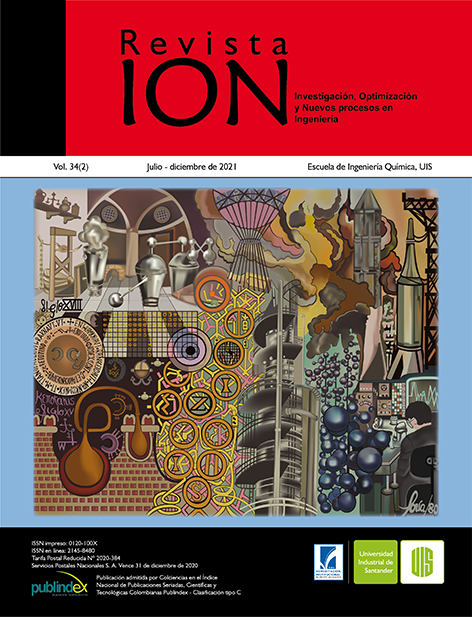Mathematical modeling and numerical simulation of a desalination plant - MSF
Published 2021-09-29
Keywords
- Distillation,
- EES®,
- Multiple stages,
- Numerical simulation
How to Cite
Abstract
The complexity of the access to drinking water problem points to the need for studies and evaluations that facilitate the use of alternative sources of drinking water able meet basic human needs and also enable the development of economic activities in these regions. In these terms, motivated by the discussion of such a relevant subject, the objective of this work was to perform the mathematical modeling and the numerical simulation of a desalination plant using the Multiple Stage Flash Distillation (MSF) method, as a desalination method to meet the existing demands. For the execution of this study, the EES® modeling software was used, in which the influence of operational parameters on the performance of the desalination plant was evaluated. The resulting model was able to reproduce the actual operationa data and forecast operating conditions. The tools of mathematical modeling and numerical simulation are important for the development of proposals of projects and efficient and viable technologies for water desalination, able to assist in water supply. In theory, its use can significantly reduce engineering time, creating the ability to test different variable
and operational options and other parameters, in a computer program, and not in physical test models. This capability
can theoretically affect the cost of the project/installation, and the final cost to the population that can take advantage
of these facilities (if constructed, installed and put into operation), eliminating the need for multiple physical prototypes
to be made and tested. The results of the study show that the number of stages is the variable that most affects the
performance of the plant, since the flow of heating steam decreases dramatically with the increase in the number of
stages, this makes the plant more efficient and economical from an energetic point of view. It is also verified that the
variables related to sea water do not provide significant variations in plant performance. And finally, the elevation of
the maximum brine temperature causes a reduction in the total area of heat transfer, however, with respect to plant
performance, the maximum brine temperature does not significantly affect this parameter in the process.
Downloads
References
[2] Voutchkov N. Desalination – Past, Present and Future - International Water Association. 17 ago. 2016. Disponível em: <https://iwa-network.org/desalination-past-presentfuture/>. Acesso em: 5 abr. 2019.
[3] Xiao G, Wang X, Ni M, Wang F, Zhu W, Luo Z, Cen K. A review on solar stills for brine desalination. Applied Energy, v. 103, p.642-652, mar. 2013.
[4] Salinas-Freire HA; Perez-Ones O, Rodriguez- Munoz S. Límites termodinámicos a la productividad de los destiladores solares pasivos. Rev. ion [online]. 2019, vol.32, n.1, pp.7-20. Epub June 03, 2019. ISSN 0120-
100X. http://dx.doi.org/10.18273/revion.v32n1-2019001.
[5] Mekhilef S, Saidur R, Safari A. A review on solar energy use in industries. Renewable and Sustainable Energy Reviews, v. 15, n. 4, p. 1777-1790, maio 2011.
[6] BCC Research. Seawater and Brackish Water Desalination (MST052C). [s.l: s.n.]. Disponível em: <https://www.bccresearch.com/market-research/membrane-andseparation-technology/seawater-brackishwater-
desalination-report-mst052d.html>. Acesso em: 13 out. 2018.
[7] Global Water Intelligence (GWI). Market profile and desalination markets, 2009-2012 yearbooks and GWI website. <http://www.desaldata.com/> Acesso em: 19 Out 2018.
[8] El-Ghonemy AMK. Performance test of a sea water multi-stage flash distillation plant: Case study. Alexandria Engineering Journal, v. 57, n. 4, p. 2401–2413, 2018
[9] Al-Karaghouli A, Kazmerski LL. Energy consumption and water production cost of conventional and renewable-energy-powered desalination processes. Renewable and Sustainable Energy Reviews, v. 24, p. 343–356, 2013.
[10] El-Dessouky HT, Ettouney HM. Fundamentals of salt water desalination. USA: Elsevier. 2002.
[11] Incropera, FP, Dewitt DP, Bergman TL, Lavine AS. Fundamentos de transferência de calor e massa. 6. ed. Rio de Janeiro: LTC, 2008. 643 p.
[12] Gnielinski V. New Equations for Heat and Mass Transfer in Turbulent Pipe and Channel Flow. International Chemical Engineering, Vol. 16, 1976.
[13] Colebrook CF. Turbulent Flow in Pipes, with Particular Reference to the Transition Region Between the Smooth and Rough Pipe Laws. Journal of the Institution of Civil Engineers. Londres. p.133-156, 1938.
[14] Fox RW, Mcdonald AT, Pritchard, PJ. Introdução à Mecânica dos Fluidos, LTC, 6a ed. 2004.
[15] Al-Fulaij H. Analysis of MSF Flashing Chambers, Master thesis. Kuwait: Kuwait University, 2002.
[16] Mazzotti M, Rosso M, Beltramini A, Morbidelli M. Dynamic modeling of multistage flash desalination plants. Desalination, vol. 127, p. 207-218, 2000.
[17] Al-Fulaij H. Dynamic modeling of multi stage flash (MSF) desalination plant. PhD thesis, University College London, 2011.
[18] Lanna PP. Modelagem matemática e simulação numérica de uma planta de dessalinização– MSF. Dissertação de Mestrado. Programa de Pós-Graduação em Engenharia Química,UFV, 2020.


